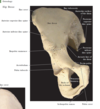ANAT 1 Pelvic and Perineal Osteology and Arthrology Flashcards





HN: The Pelvis, or Pelvic cavity is the region of the trunk inferoposterior to the Abdomen, between the Pelvic Brim and Pelvic Diaphragm. The Pelvis is also the transition point between trunk and Lower Extremity. The Perineum is the area of the trunk between the Thighs and Buttocks, from the Coccyx to the Pubis, inferior to the Pelvic Diaphragm.












Suprapubic angle in males and females?





The bony pelvis includes? (3)
pelvic girdle describes? which are joined where?
The Bony Pelvis includes the Paired Coxal Bones, The Sacrum and the Coccyx. The Pelvic Girdle describes the paired Coxal Bone, which are joined anteriorly at the Pubic Symphysis.
Spondylolysis vs spondylolisthesis at L5
L5 Spondylolysis: Separation of the vertebral arch from the vertebral body. L5 Spondylolisthesis: Abnormal anteriorly directed separation of the L5 vertebral segment from the Sacrum.

superior and inferior pelvic aperture
exists where made up of?
The Bony Pelvis has a Superior and Inferior Pelvic Aperture. The Superior Pelvic Aperture (Pelvic Inlet) exists at the Pelvic Brim, between the Greater and Lesser Pelves, and is formed by the Sacral Promentory, Superior edge of the Sacral Ala, Arcuate Line of the Ilium, Pectin Pubis, posterior edge of the Pubic crest and superior edge of the Pubic Symphysis. The Inferior Pelvic Aperture (Pelvic Outlet) is bound by the inferior edge of the Pubic Symphysis, Inferior Pubic and Ischial Rami, Ischial Tuberosities, Sacrotuberous Ls. and the Coccyx. The Pelvic Canal is the passage between the two Apertures.

sexual differences in pelves?
Sexual Differences in Pelves: Males have thicker, heavier Pelves, a deeper greater Pelvis, narrower and deeper lesser Pelvis, Android Pelvic Inlet, small Pelvic Outlet, narrow Pubic Arch, round Obturator Foramen and large Acetabulum. Females have thinner, lighter Pelves, a shallow greater Pelvis, wide and shallow lesser Pelvis, Gynecoid Pelvic Inlet, large Pelvic Outlet, wide Pubic Arch, oval-shaped Obturator Foramen and small Acetabulum.

Pelvic shapes?
(4)
Pelvic Shapes include the Android (classically male), gynecoid (classically female), Anthropoid (elongated anterior to posterior) and Platypelloid (elongated laterally)

pelvic diameters are important why?
Pelvic Diameters (Conjugates) are important measurements obstetrically to determine the capacity of a female to bear a child.

Pelvic fractures? almost always involve? why?
often broken in this kind of injury?
Pelvic Fractures or crush fractures almost always involve multiple fractures given that the articulated Pelvis is a bony ring and therefore difficult to break in only one place. The Superior and Inferior Pubic Rami are often broken on both side as a result of this kind of injury.


























































